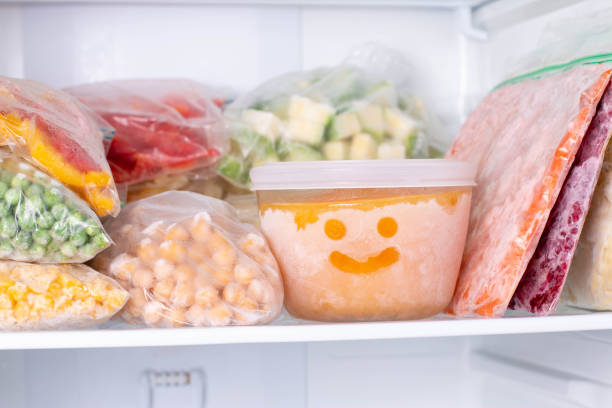The term “frozen foods” conjures images of popsicles and ice cream. However, these days, frozen foods are much more than that. Today’s food technology has made it possible to freeze fresh foods in such a way that they retain all their nutrition and taste.
They can even keep certain nutrients locked inside until you are ready to eat them. This article explores the differences between fresh and frozen foods nutritionally and how to get the most out of both.

Fresh Foods vs Frozen Foods: What’s the difference?
Frozen foods are simply food that has been frozen to preserve their nutrient content at peak freshness. Frozen foods are generally very nutritious, as the process of freezing only slows down the process of decomposition.
While frozen foods are simply frozen, fresh foods are frozen after harvesting but before they are sold. Most fresh foods can be stored for a few days or up to a few weeks in the freezer without losing a lot of their quality or taste.
What is frozen food?
Frozen foods are part of a category of foods called “concentrate.” Concentrate foods are food that has undergone an intensive freeze-thaw process to break down the cell walls in the food itself.
This is the same process that leaches out most of the water from fresh fruits and vegetables, turning them into dehydrated “concentrate” foods. In addition to concentration, frozen foods are also pasteurized, which kills any harmful bacteria that may be present in the food.
Why freeze your food?
Freezing foods is a great way to preserve fresh produce for the winter and extend its shelf life. When you eat fresh fruits and vegetables, they are very perishable. They start with a short lifespan because they are picked too soon and become damaged by the weather and other environmental factors, such as pests and lack of proper storage.
After a few days, they start to look less appealing, become less juicy and taste less fresh and vibrant. Eventually, they become so damaged that they start to lose nutrients and taste. This is when you should start eating them. Foods that are not frozen, but are consumed right after being picked, will only last for a few days. This is the reason why people don’t eat the same products every day.

Which foods can you freeze?
Fruits: apples, avocados, bananas, blueberries, papayas, peaches, pears, strawberries, etc. Vegetables: carrots, broccoli, cauliflower, etc.
Benefits of freezing
- Very low risk of food poisoning: Foods that have been frozen are at very low risk of bacterial contamination, and as a result, do not require the use of refrigeration, which is the main source of food poisoning.
- Very low risk of nutrient loss: While there is some nutrient loss during the thawing process, this is not as great as the nutrient loss that comes from washing, peeling and chopping fresh produce.
- Can be prepared in advance: A freezer can be a great asset to anyone who cares about eating healthy, nutritious food regularly.
- Save money: Food that has been frozen is cheaper than fresh produce, especially when you consider how much produce you will use when preparing the same dish with fresh ingredients.
- Can last longer than fresh produce: Foods that have been frozen can last for up to a year, depending on the type of food and how well it has been frozen.
- Convenient: Freezing food allows you to prepare healthy meals in advance, thus saving you from having to buy groceries too often.
- Environmentally friendly: The thawing and refreezing process of frozen food reduce to almost zero the number of greenhouse gases released into the environment.
- Easier to transport: Frozen foods are lighter and can be easily transported by air or sea.
- No waste: If you don’t eat your frozen foods, you don’t have to worry about wasting good food. You can just let it sit in the freezer and wait for the time to pass.

Choosing fresh over frozen
Fresh produce is always best, but if you are short on time or don’t have the opportunity to pick your produce, frozen vegetables can be a good alternative. However, doing your research first can help you make an informed decision.
Knowing the nutritional value of fresh and frozen vegetables can help you make an informed decision. If there is any chance that the vegetables were sprayed with pesticides, then frozen is the best option. If you can’t tell, then frozen is probably the best option. When buying fresh produce, make sure you select organically grown produce whenever possible. This way, you can be sure that the product you are buying is free of pesticides.
Tips when choosing fresh or frozen foods
- Make sure to check the expiry date on the food packaging.
- Before you freeze food, make sure it is clean and free of germs.
- Thaw frozen food in the fridge. Do not thaw frozen food in the microwave or by placing the thawed food in a bowl with warm water.
- Never leave food out longer than 24 hours.
- Use your food as soon as possible.
- Freeze food in a freezer that is set to -18° C or below.
- Keep food as cold as possible.
- Use your food as soon as possible after it has been thawed.
Conclusion
Fresh foods are simply food that has not gone through the freeze-thaw process. They are eaten as they are, and they are the healthiest option. Fresh foods are a low risk of food poisoning and offer greater taste and many vitamins and minerals. They can be eaten as soon as possible after picking them up from the garden or the supermarket.







